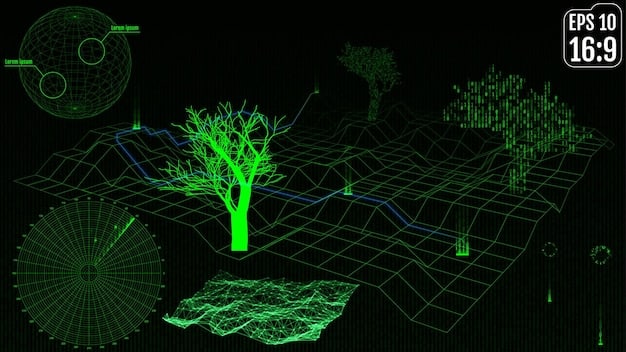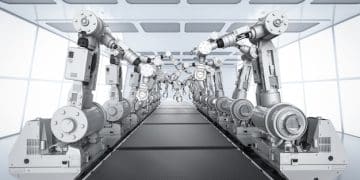Emerging AI Trends for Climate Change Mitigation and Adaptation in the US

Emerging trends in AI research for climate change mitigation and adaptation in the US include advancements in predictive modeling, optimization of energy consumption, enhancement of carbon capture technologies, and improvement of climate resilience strategies.
The climate crisis demands innovative solutions, and artificial intelligence (AI) is emerging as a powerful tool in the fight. But what are the emerging trends in AI research for climate change mitigation and adaptation in the US? This article delves into them, exploring how AI is being developed to model climate patterns, optimize energy use, and enhance carbon capture technologies in the United States.
Artificial Intelligence: A Climate Change Game Changer?
Artificial intelligence is rapidly transforming various sectors, and its potential impact on climate change mitigation and adaptation is particularly promising. As the US grapples with the urgent need for sustainable solutions, AI research is at the forefront, driving innovation and offering new strategies to address the challenges.
This section will explore why AI is considered a potential game changer in the climate change arena and set the stage for a deeper dive into the emerging trends in this field.
The Scope of AI’s Potential in Climate Action
AI’s ability to process vast amounts of data quickly and efficiently makes it invaluable for understanding complex climate patterns and predicting future impacts. Its capacity to optimize processes and resource allocation can lead to significant reductions in greenhouse gas emissions. Here are examples of AI applications for climate action:
- Predictive Modeling: AI algorithms can analyze climate data to create more accurate predictive models, helping policymakers and communities prepare for extreme weather events.
- Energy Optimization: AI can optimize energy consumption in buildings, transportation systems, and industrial processes, reducing waste and lowering carbon emissions.
- Carbon Capture: AI can assist in discovering and optimizing new materials and processes for carbon capture, making it more efficient and cost-effective.
- Climate Resilience: AI can help communities build resilience to climate change impacts by identifying vulnerabilities and developing targeted adaptation strategies.
Although AI offers great promise, it’s important to consider the challenges and limitations. Ethical considerations, data privacy concerns, and the energy footprint of AI itself must be addressed to ensure its sustainable implementation.

Predictive Modeling: Forecasting Future Climate Scenarios
One of the most crucial applications of AI in climate change research is predictive modeling. Traditional climate models often struggle with the complexity and variability of climate systems. AI, with its ability to learn from data and identify patterns, is revolutionizing how we forecast future climate scenarios.
This section will delve into how AI is enhancing climate models, improving the accuracy of predictions, and providing actionable insights for policymakers and communities.
Enhancing Climate Models with Machine Learning
Machine learning algorithms can analyze vast datasets of climate variables – temperature, precipitation, sea levels, and more – to identify complex relationships and improve the accuracy of climate models. Here are key benefits:
- Improved Accuracy: AI-driven models can capture more nuances in climate patterns, leading to more accurate predictions.
- Faster Processing: AI can process large datasets much faster than traditional methods, allowing for quicker updates and adjustments to models.
- Better Integration: AI can integrate data from various sources, including satellite imagery, weather stations, and ocean buoys, to provide a more holistic view of the climate system.
For instance, Google’s Flood Forecasting Initiative uses AI to predict floods with greater accuracy and lead time, enabling communities to prepare and evacuate in advance. Similarly, researchers are using AI to model and predict wildfires, helping to allocate firefighting resources more effectively.
Predictive modeling also assists in long-term planning. By forecasting the potential impacts of climate change on different regions, AI can inform decisions about infrastructure development, resource management, and land use planning.
Optimizing Energy Consumption: Reducing Carbon Footprints
Energy consumption is a major contributor to greenhouse gas emissions, and optimizing energy use is a critical step in climate change mitigation. AI is being used to develop smart grids, improve energy efficiency in buildings, and optimize industrial processes.
This section will examine how AI is optimizing energy consumption, reducing carbon footprints in various sectors, and explore examples of successful AI-driven energy management.
AI-Powered Smart Grids
Smart grids use AI to manage and distribute electricity more efficiently. AI algorithms can analyze real-time data on energy demand and supply, optimizing the flow of electricity and reducing waste. Benefits of AI-powered smart grids include:
- Efficient Distribution: AI can balance the load across the grid, preventing overloads and ensuring a stable power supply.
- Renewable Energy Integration: AI can manage the intermittent nature of renewable energy sources like solar and wind, ensuring a reliable supply of clean energy.
- Demand Response: AI can predict energy demand and adjust supply in real-time, reducing the need for peaking power plants.
Energy Efficiency in Buildings
AI can optimize energy consumption in buildings by analyzing factors such as occupancy, weather conditions, and building characteristics. Smart building systems can adjust heating, cooling, and lighting to minimize energy use. For example:
- Smart Thermostats: AI-powered thermostats learn user preferences and adjust temperatures automatically, reducing energy waste.
- Automated Lighting: AI can control lighting systems based on occupancy and natural light levels, saving electricity.
- Predictive Maintenance: AI can predict when equipment needs maintenance, preventing breakdowns and ensuring optimal energy efficiency.
Industrial processes can also be optimized using AI. AI algorithms can analyze data from sensors and machines to identify areas for improvement, reducing energy consumption and improving productivity.

Enhancing Carbon Capture Technologies: Removing CO2 from the Atmosphere
Carbon capture technologies are essential for removing CO2 from the atmosphere and mitigating the impact of greenhouse gas emissions. AI is playing a crucial role in discovering and optimizing new materials and processes for carbon capture, making it more efficient and cost-effective.
This section will explore how AI is enhancing carbon capture technologies, discuss the benefits and challenges of AI-driven carbon capture, and highlight cutting-edge research in this field.
AI-Driven Discovery of New Materials
AI can accelerate the discovery of new materials for carbon capture by analyzing vast databases of chemical compounds and predicting their performance. Benefits of AI-driven material discovery include:
- Faster Discovery: AI can identify promising materials much faster than traditional trial-and-error methods.
- Improved Performance: AI can design materials with higher CO2 absorption rates and better stability.
- Cost Reduction: AI can identify materials that are more abundant and less expensive to produce.
For instance, researchers are using AI to design new metal-organic frameworks (MOFs) that can selectively capture CO2 from the air. These AI-designed MOFs have shown promising results in laboratory tests, demonstrating the potential for AI to revolutionize carbon capture.
Improving Climate Resilience Strategies: Preparing for the Inevitable
Even with aggressive mitigation efforts, some degree of climate change is inevitable. Improving climate resilience strategies is essential for protecting communities and ecosystems from the impacts of climate change. AI is being used to identify vulnerabilities, develop targeted adaptation strategies, and optimize resource allocation.
This section will examine how AI is improving climate resilience strategies, discuss examples of AI-driven adaptation planning, and explore the role of AI in disaster preparedness and response.
Identifying Vulnerabilities with AI
AI can analyze data on demographics, infrastructure, and environmental conditions to identify communities and ecosystems that are most vulnerable to climate change impacts. AI applications for vulnerability analysis include:
- Risk Assessment: AI can assess the risk of extreme weather events, such as floods, droughts, and heatwaves, for different regions.
- Infrastructure Mapping: AI can map critical infrastructure and identify vulnerabilities, such as bridges and power grids that are at risk.
- Community Profiling: AI can analyze demographic data to identify vulnerable populations, such as low-income communities and elderly residents.
AI in Disaster Preparedness and Response
AI can play a vital role in disaster preparedness and response by predicting the impact of disasters, optimizing resource allocation, and coordinating relief efforts. For example:
- Early Warning Systems: AI can analyze real-time data to provide early warnings of impending disasters, such as hurricanes and wildfires.
- Resource Allocation: AI can optimize the allocation of resources, such as medical supplies and emergency personnel, to areas that need them most.
- Coordination of Relief Efforts: AI can coordinate relief efforts by tracking the location of resources and personnel, and by facilitating communication between different agencies.
Challenges and Opportunities in US AI Climate Research
While AI offers immense potential for climate change mitigation and adaptation, several challenges and opportunities lie ahead. Addressing these challenges and capitalizing on the opportunities will be crucial for maximizing the impact of AI in the fight against climate change.
This section will explore the challenges and opportunities in US AI climate research, discuss the role of collaboration and funding, and highlight the ethical considerations surrounding AI deployment.
Ethical Considerations
The use of AI in climate change research raises several ethical considerations, including data privacy, algorithmic bias, and the potential for unintended consequences. Addressing these ethical considerations is essential for ensuring that AI is used responsibly and equitably. Consider these areas:
- Data Privacy: AI algorithms often rely on large datasets of personal information, raising concerns about data privacy and security.
- Algorithmic Bias: AI algorithms can perpetuate and amplify existing biases in the data, leading to unfair or discriminatory outcomes.
- Unintended Consequences: AI systems can have unintended consequences that are difficult to predict or control, such as displacing workers or exacerbating social inequalities.
| Key Point | Brief Description |
|---|---|
| 🌍 Predictive Modeling | AI enhances climate models for more accurate forecasting. |
| ⚡ Energy Optimization | Smart grids and efficient buildings reduce carbon footprints. |
| 🌱 Carbon Capture | AI aids in discovering innovative CO2 removal technologies. |
| 🛡️ Climate Resilience | AI creates strategies to protect communities from climate impacts. |
Frequently Asked Questions
▼
AI’s primary role involves enhancing analytical capabilities to improve predictive modeling and energy optimization, which helps in devising better strategies for reducing greenhouse gas emissions.
▼
AI improves energy consumption through smart thermostats and automated systems that learn usage patterns and adjust settings like heating, cooling, and lighting according to occupancy and real-time weather conditions.
▼
MOFs are materials used for carbon capture, and AI helps by rapidly analyzing chemical databases to design MOFs with better CO2 absorption, stability and cost-effectiveness, significantly accelerating discovery and optimization.
▼
Yes, AI can analyze vast datasets (weather patterns, land availability, grid connectivity) to determine ideal locations for renewable energy, maximizing energy production and grid efficiency, providing data-driven insights.
▼
Ethical considerations include data privacy, algorithmic biases that could discriminate, and the potential for unintended consequences. These issues require careful consideration and governance to ensure equitable AI deployments.
Conclusion
Artificial intelligence is poised to play a transformative role in climate change mitigation and adaptation in the United States. By leveraging AI’s capabilities in predictive modeling, energy optimization, carbon capture, and climate resilience, the US can develop more effective and sustainable solutions to address the climate crisis. As AI research continues to advance, it is crucial to address the challenges and ethical considerations to ensure that AI is used responsibly and equitably for the benefit of all.





